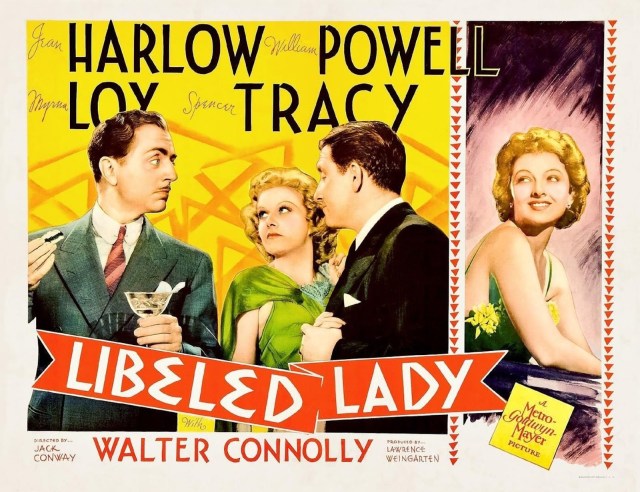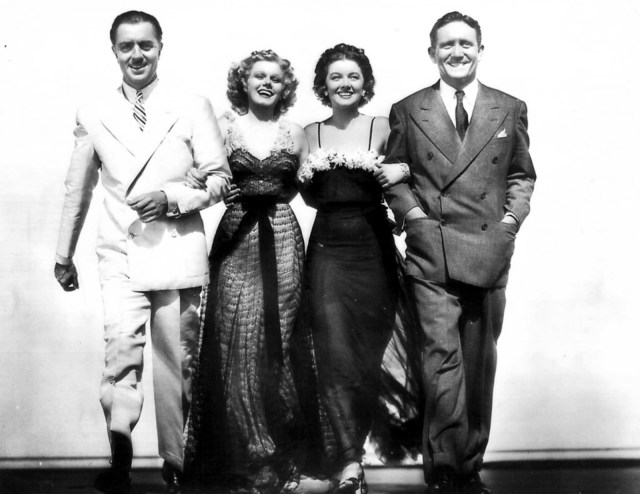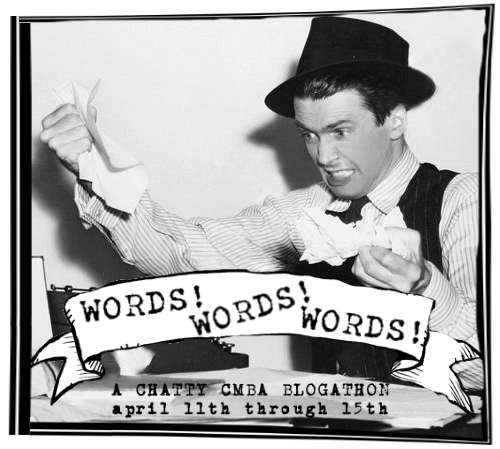
When I teach Film Study to my high school students, I always emphasize that for every one actor we see on screen, there are dozens of other people behind the camera who also hold a crucial part in making a film come to life. In the case of Libeled Lady, audiences are given the delightful opportunity of seeing some of the best actors of the 1930s enact a sidesplitting story written by Maurine Dallas Watkins, Howard Emmett Rogers, and George Oppenheimer, under the careful direction of Jack Conway. The film stars Jean Harlow, William Powell, Myrna Loy, and Spencer Tracy.
The 1930s granted cinemagoers a wide variety of exceptional films, including the immensely successful genre of screwball comedy. With the dream writing team of Watkins, Rogers, and Oppenheimer, Libeled Lady is aglow with their comic expertise. A glimpse into the careers of these writers offers an impressive resume of film projects.

After attending four different colleges, Maurine Dallas Watkins graduated at the top of her class from Butler College, which is now Butler University. She moved to Massachusetts to study Greek, and was accepted into a playwriting workshop led by English Professor George Pierce Baker at Harvard University. The workshop director recommended that she seek experience in the journalistic setting, so Watkins moved to Chicago and accepted a position working for the Chicago Tribune.
While working for the Tribune, Watkins covered the trials of cabaret singer Belva Gaertner and Beulah Sheriff Annan, reporting on the sensationalist aspects of the cases. Soon after Belva Gaertner was acquitted of charges of murder, Watkins returned to school and studied under Baker once again, but this time at Yale University. As an assignment for his class, she wrote a fictionalized account of the Gartner and Annan trials. Her assignment eventually became the play Chicago, with Annan’s name switched to “Roxie Hart,” and Gaertner’s as “Velma Kelly.” Chicago is considered her most successful play.

After the success of Chicago, Watkins moved to Hollywood to write screenplays. In addition to writing for Libeled Lady, she also wrote for Harlow once again in Saratoga (1937). Unfortunately, Harlow would pass away during the production of this film, causing the remainder of the film to be shot with a body double in her stead. Watkins would also write for Libeled Lady’s remake, Easy to Wed (1946).
A professional screenwriter since 1926, Howard Emmett Rogers worked for Paramount Pictures as well as the Harold Lloyd Corporation. While working for the latter, Rogers assisted in writing the screenplay for Speedy (1928). From the early 1930s until the early 1950s, Rogers worked most frequently for MGM, where he helped write Tarzan and His Mate (1934) and For Me and My Gal (1942), among other films. Rogers spent his final years working for MGM’s British division.

George Oppenheimer began his career as an advertising publications manager and eventually became the co-founder of Viking Press in 1925. In 1933, he moved to Hollywood, under contract to complete the screenplay for Roman Scandals (1933). The original writers of the screenplay, George S. Kaufman and Robert E. Sherwood, had since left the project because they felt that Eddie Cantor was becoming far too involved in the control of their script. Upon completing Roman Scandals, Oppenheimer remained with MGM as a script doctor, working to improve the written output of his screenwriting peers. Oppenheimer’s work beyond Libeled Lady includes other comedic films, such as A Day at the Races (1937) and A Yank at Oxford (1938).

Watkins, Rogers, and Oppenheimer would later reunite to pen Libeled Lady’s remake, Easy to Wed (1946), starring Van Johnson, Esther Williams, Lucille Ball, and Keenan Wynn.

Director Jack Conway, on the other hand, first entered the film industry in front of the camera as an actor. Upon becoming a member of D.W. Griffith’s stock company in 1911, he often appeared as a male lead in various westerns. In 1913, he decided to pursue a career as a director, and briefly worked for Universal. Conway moved to MGM in 1925 and is credited with directing the studio’s first sound feature, Alias Jimmy Valentine (1928). Because of his ability to supply commercially successful films on time and within the studio’s budget, Conway remained under contract with MGM for twenty years, with Libeled Lady being commended by the New York Times for Conway’s “agile direction.”

Myrna Loy and Jack Conway
Libeled Lady is a sophisticated screwball comedy, which tells the story of an heiress named Connie Allenbury (Myrna Loy) who is wrongly accused of breaking up a marriage. As a result, she decides to sue the publication in question to the tune of five million dollars for libel. Managing editor Warren Haggerty (Spencer Tracy) enlists the help of his suave former reporter friend, Bill Chandler (William Powell).
Warren: Where did you go when you left us, Bill?
Bill: Intelligence Department, Warren. I always did like contrast.
Warren decides that the lawsuit can be dropped if Bill’s wife walks in on Bill with Connie. However, Bill does not have a wife. In response, Warren volunteers his long-suffering fiancée, Gladys Benton (Jean Harlow), to marry Bill.
Warren: Would I ask you to do this thing for me if I didn’t consider you practically my wife?
Gladys: Would you ask your wife to hook up with that ape?
Bill: The ape objects.
With the idea of pursuing a quick Reno divorce once the lawsuit is dropped, Gladys and Bill marry.
Magistrate: Well, I hope you’ll be very happy. And don’t forget to invite me to your silver anniversary.
Gladys: It’ll have to be in the next six weeks!
Bill returns to America on the same ship as Connie and her father, J.B. (Walter Connolly). In order to meet Connie, Bill pays some men to pose as reporters and harass her at the dock, so that he can seem to save her and gain her trust. Although Connie initially dismisses him as a gold-digger, she eventually warms up to him.
J.B: That man is a first-class angler.
Connie: If he’s first-class, I’m traveling steerage!
Gladys begins to fall for Bill after being engaged to Warren for far too long and decides to keep Bill as her husband. Meanwhile, Warren is oblivious. Bill learns that Gladys’ initial divorce from a previous marriage was never finalized, therefore rendering their marriage invalid and allowing him to marry Connie. However, Bill and Connie also happen to fall in love with one another and do get married. When Gladys interrupts their honeymoon by demanding her husband back, Bill reveals his loophole, but Gladys tops him with a surprise of her own. When Warren finds out that his own relationship is in jeopardy, he also rushes to the scene.
Warren: She may be his wife, but she’s engaged to me!
With love, marriages, and chaos running rampant, the film is a turbulent and constantly entertaining success. However, the stories behind the making of this film during its three-month shoot are also intriguing.
First of all, the cast of Harlow, Powell, Loy, Tracy, and Connolly was not originally intended. Rosalind Russell was initially being considered for the role of Connie. Additionally, the role of J.B. was initially offered to Lionel Barrymore. However, once casting decisions were finalized, MGM decided that this would film would be another Powell-Loy vehicle.

Loy and Powell proved to have fantastic chemistry on screen and quickly became a favorite film couple for comedy fans. Throughout their careers, they worked with one another in a total of fourteen films. While Libeled Lady is their fifth film, some of their most famous works include the six films comprising the Thin Man series. They became well-known to audiences as Nick and Nora Charles, a dashing detective and his glamorous heiress wife, alongside their canine sidekick, Asta. Moreover, they portrayed their couples so well in their films that people assumed they were actually married. In fact, when they arrived in San Francisco to shoot the Thin Man, the hotel management there had booked them a shared suite, thinking that they were married. When Powell passed away at the age of 91, Loy recalled, “I never enjoyed my work more than when I worked with William Powell. He was a brilliant actor, a delightful companion, a great friend and, above all, a true gentleman.”

However, behind the scenes, Powell and Harlow were really a couple. The two worked together in the 1935 film Reckless, and their romance began. Interestingly, they were surprised to find out that they were both from Kansas City, Missouri, and had only lived blocks away from each other. However, they never actually met until they were established actors. Harlow considered Powell to be the love of her life, especially since he supported one of her innermost desires: to be a writer. After she once mentioned that she never seemed to have enough paper, she one day found two messengers delivering white bond paper, clips, two erasers and four dozen pencils at her door from Powell. His note to her read, “Just fill these up with words.” She felt that he truly saw her as a person. The two became engaged in 1936, and Harlow’s blue sapphire engagement ring can be spotted in Saratoga.

When Harlow was signed on to work on Libeled Lady, she wanted to play the part of Connie so that her character and Powell’s would wind up together. Although she eventually accepted the part of Gladys, she did get to play out an amusing wedding scene with Powell. Unfortunately, their relationship and engagement ended when she tragically died in 1937 from uremia. Powell’s distress over her passing coupled with receiving a cancer diagnosis that same year caused him to accept fewer acting roles.

Libeled Lady is brimming with fantastic comedic moments. One highlight includes a fishing scene in which Powell displays his knack for physical comedy. Bill attempt to impress Connie with his trout fishing skills and the two split up for some friendly competition. Connie’s scenes of poise and elegance throughout the fishing experience are juxtaposed with Bill’s hilarious struggle. His volume of Trout Fishing for Beginners does not stop him from becoming a soaking wet disaster within minutes, although he does succeed in catching a fish and Connie’s affection by the end.

Jean Harlow’s character of Gladys has a fantastic entrance as the once-again jilted bride of Warren. As the film’s background music serenades us with the wedding march, a furious Gladys storms down the aisle of a busy newsroom in full bridal regalia to shoot scathing remarks at her groom-to-be.

A success at the box office, Libeled Lady received an Academy Award nomination for Best Picture in 1937. However, the film lost to The Great Ziegfeld (1936), which also happened to star William Powell and Myrna Loy.

Libeled Lady is a wonderful film, which is as witty today as it was upon its initial release. Thanks to the immeasurable talents of many individuals, this film is sure to delight fans of classic cinema for generations to come.
This post is part of the Classic Movie Blog Association’s Spring Blogathon, entitled, “Words! Words! Words!” To access more information and read accompanying posts, please click on the following picture:
As part of this blogathon’s theme, I recently co-authored an e-book, entitled Words! Words! Words!: Essays on Writers and Writing in Classic Film. You may purchase your very own edition through Amazon. All proceeds are donated to film preservation. Check it out!








Thorough and entertaining look at the creators of “Libeled Lady”, one of the best movies of the 30s, has me aching to see it again soon.
Thanks so much!
Thanks for the lovely write up. I had no idea that Jean Harlow wanted to write!
She did indeed! In fact, she published the novel Today is Tonight.
Aww! I love that William Powell had all those writing supplies delivered to Jean Harlow. What a romantic and thoughtful thing to do.
Yes, like Caftan Woman above, I’m yearning to see Libeled Lady again. So many great lines!
Yet another reason to adore William Powell! 🙂
Loved the in-depth look at the writers and director! Fantastic post on a great movie!
Loved your post – always great to know something about the authors of those fast and furious words.
Pingback: Myrna Loy | Hometowns to Hollywood
Pingback: Van Johnson | Hometowns to Hollywood
Pingback: Spencer Tracy | Hometowns to Hollywood
Sometimes I try to imagine what Jean would have been doing if she’d lived. Character roles? She could have aced those. A 50’s sitcom to put I Love Lucy to shame? She could ace that as well. But I like to think of her settled into happy domesticity and writing, with kids, dogs…maybe an occasional book tour, but a mostly quiet life. I think she’d have liked that best.
Thanks for the comment! Those are all sweet thoughts for her. Such a tragedy that she died so young. Like you, I think the highest priority would have just been to see her happy and well.
Pingback: Jean Harlow | Hometowns to Hollywood
Wonderful post on a perfectly cast film. I love the little story about William Powell’s loving encouragement of Jean Harlow’s passion of writing. Myrna Loy told of a note she received after Jean Harlow died from a friend.The friend expressed condolences and said how he imagined that Jean was probably missing sitting on Bill’s lap and that he remembered that adoring look she gave Powell.
Pingback: Esther Williams | Hometowns to Hollywood